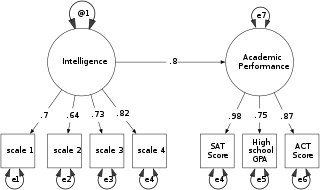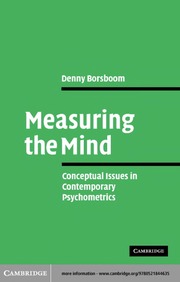Related Research Articles
Psychological statistics is application of formulas, theorems, numbers and laws to psychology. Statistical Methods for psychology include development and application statistical theory and methods for modeling psychological data. These methods include psychometrics, Factor analysis, Experimental Designs, and Multivariate Behavioral Research. The article also discusses journals in the same field.
Psychometrics is a field of study concerned with the theory and technique of psychological measurement. As defined by the US National Council on Measurement in Education (NCME), psychometrics refers to psychological measurement. Generally, it refers to the specialist fields within psychology and education devoted to testing, measurement, assessment, and related activities.
In the social sciences, scaling is the process of measuring or ordering entities with respect to quantitative attributes or traits. For example, a scaling technique might involve estimating individuals' levels of extraversion, or the perceived quality of products. Certain methods of scaling permit estimation of magnitudes on a continuum, while other methods provide only for relative ordering of the entities.
In psychometrics, item response theory (IRT) is a paradigm for the design, analysis, and scoring of tests, questionnaires, and similar instruments measuring abilities, attitudes, or other variables. It is a theory of testing based on the relationship between individuals' performances on a test item and the test takers' levels of performance on an overall measure of the ability that item was designed to measure. Several different statistical models are used to represent both item and test taker characteristics. Unlike simpler alternatives for creating scales and evaluating questionnaire responses, it does not assume that each item is equally difficult. This distinguishes IRT from, for instance, Likert scaling, in which "All items are assumed to be replications of each other or in other words items are considered to be parallel instruments" (p. 197). By contrast, item response theory treats the difficulty of each item as information to be incorporated in scaling items.

A Likert scale is a psychometric scale commonly involved in research that employs questionnaires. It is the most widely used approach to scaling responses in survey research, such that the term is often used interchangeably with rating scale, although there are other types of rating scales.

A personality test is a method of assessing human personality constructs. Most personality assessment instruments are in fact introspective self-report questionnaire measures or reports from life records (L-data) such as rating scales. Attempts to construct actual performance tests of personality have been very limited even though Raymond Cattell with his colleague Frank Warburton compiled a list of over 2000 separate objective tests that could be used in constructing objective personality tests. One exception however, was the Objective-Analytic Test Battery, a performance test designed to quantitatively measure 10 factor-analytically discerned personality trait dimensions. A major problem with both L-data and Q-data methods is that because of item transparency, rating scales and self-report questionnaires are highly susceptible to motivational and response distortion ranging all the way from lack of adequate self-insight to downright dissimulation depending on the reason/motivation for the assessment being undertaken.
Level of measurement or scale of measure is a classification that describes the nature of information within the values assigned to variables. Psychologist Stanley Smith Stevens developed the best-known classification with four levels, or scales, of measurement: nominal, ordinal, interval, and ratio. This framework of distinguishing levels of measurement originated in psychology and is widely criticized by scholars in other disciplines. Other classifications include those by Mosteller and Tukey, and by Chrisman.

A questionnaire is a research instrument consisting of a series of questions for the purpose of gathering information from respondents. The questionnaire was invented by the Statistical Society of London in 1838.

Structural equation modeling (SEM) is a label for a diverse set of methods used by scientists in both experimental and observational research across the sciences, business, and other fields. It is used most in the social and behavioral sciences. A definition of SEM is difficult without reference to highly technical language, but a good starting place is the name itself.
The Rasch model, named after Georg Rasch, is a psychometric model for analyzing categorical data, such as answers to questions on a reading assessment or questionnaire responses, as a function of the trade-off between (a) the respondent's abilities, attitudes, or personality traits and (b) the item difficulty. For example, they may be used to estimate a student's reading ability or the extremity of a person's attitude to capital punishment from responses on a questionnaire. In addition to psychometrics and educational research, the Rasch model and its extensions are used in other areas, including the health profession, agriculture, and market research because of their general applicability.
In social science research, social-desirability bias is a type of response bias that is the tendency of survey respondents to answer questions in a manner that will be viewed favorably by others. It can take the form of over-reporting "good behavior" or under-reporting "bad", or undesirable behavior. The tendency poses a serious problem with conducting research with self-reports. This bias interferes with the interpretation of average tendencies as well as individual differences.
A rating scale is a set of categories designed to elicit information about a quantitative or a qualitative attribute. In the social sciences, particularly psychology, common examples are the Likert response scale and 1-10 rating scales in which a person selects the number which is considered to reflect the perceived quality of a product.
In statistics, inter-rater reliability is the degree of agreement among independent observers who rate, code, or assess the same phenomenon.
Consensus-based assessment expands on the common practice of consensus decision-making and the theoretical observation that expertise can be closely approximated by large numbers of novices or journeymen. It creates a method for determining measurement standards for very ambiguous domains of knowledge, such as emotional intelligence, politics, religion, values and culture in general. From this perspective, the shared knowledge that forms cultural consensus can be assessed in much the same way as expertise or general intelligence.
Differential item functioning (DIF) is a statistical characteristic of an item that shows the extent to which the item might be measuring different abilities for members of separate subgroups. Average item scores for subgroups having the same overall score on the test are compared to determine whether the item is measuring in essentially the same way for all subgroups. The presence of DIF requires review and judgment, and it does not necessarily indicate the presence of bias. DIF analysis provides an indication of unexpected behavior of items on a test. An item does not display DIF if people from different groups have a different probability to give a certain response; it displays DIF if and only if people from different groups with the same underlying true ability have a different probability of giving a certain response. Common procedures for assessing DIF are Mantel-Haenszel, item response theory (IRT) based methods, and logistic regression.
In statistics, confirmatory factor analysis (CFA) is a special form of factor analysis, most commonly used in social research. It is used to test whether measures of a construct are consistent with a researcher's understanding of the nature of that construct. As such, the objective of confirmatory factor analysis is to test whether the data fit a hypothesized measurement model. This hypothesized model is based on theory and/or previous analytic research. CFA was first developed by Jöreskog (1969) and has built upon and replaced older methods of analyzing construct validity such as the MTMM Matrix as described in Campbell & Fiske (1959).

Measuring the Mind: Conceptual Issues in Contemporary Psychometrics is a book by Dutch academic Denny Borsboom, Assistant Professor of Psychological Methods at the University of Amsterdam, at time of publication. The book discusses the extent to which psychology can measure mental attributes such as intelligence and examines the philosophical issues that arise from such attempts.
The theory of conjoint measurement is a general, formal theory of continuous quantity. It was independently discovered by the French economist Gérard Debreu (1960) and by the American mathematical psychologist R. Duncan Luce and statistician John Tukey.
Psychometric software is software that is used for psychometric analysis of data from tests, questionnaires, or inventories reflecting latent psychoeducational variables. While some psychometric analyses can be performed with standard statistical software like SPSS, most analyses require specialized tools.
The Mokken scale is a psychometric method of data reduction. A Mokken scale is a unidimensional scale that consists of hierarchically-ordered items that measure the same underlying, latent concept. This method is named after the political scientist Rob Mokken who suggested it in 1971.
References
- Michell, J (1990). An Introduction to the logic of Psychological Measurement. Hillsdales, NJ: Lawrences Erlbaum Associates Publ.